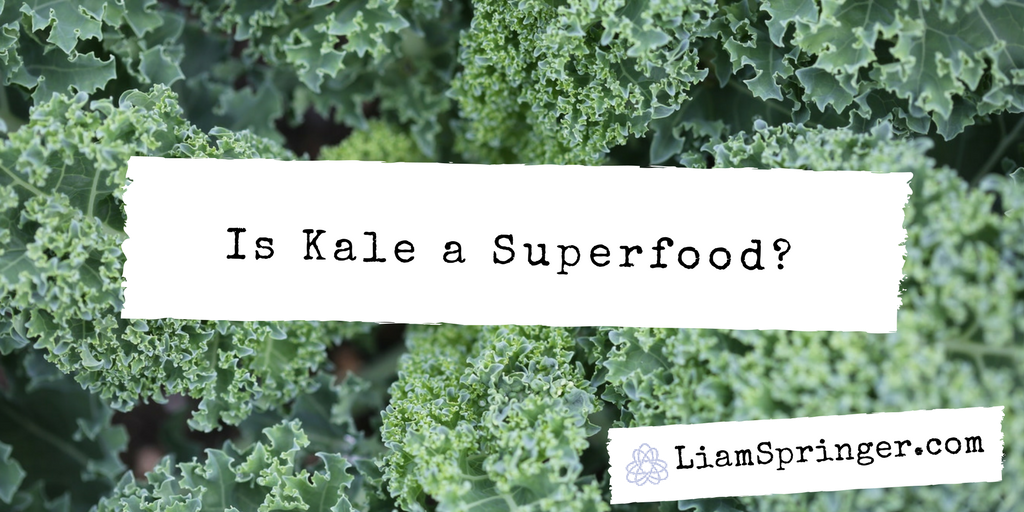 Kale has been a trendy health food for some time. It is often lauded as being a “powerhouse” of nutrients packed with loads of vitamin A, vitamin K, iron, and calcium. But is kale a superfood? Just because a food is dense in nutrients, does that automatically mean that it is the best and healthiest choice for human consumption? Are there other factors to consider? Keep reading to learn a better definition for the term “superfood” and find out why kale is not included on my list of top superfoods.
Kale has been a trendy health food for some time. It is often lauded as being a “powerhouse” of nutrients packed with loads of vitamin A, vitamin K, iron, and calcium. But is kale a superfood? Just because a food is dense in nutrients, does that automatically mean that it is the best and healthiest choice for human consumption? Are there other factors to consider? Keep reading to learn a better definition for the term “superfood” and find out why kale is not included on my list of top superfoods.
What Is the Definition of Superfood?
A superfood not only supplies the energy needed to fuel the body, but also the vitamins and minerals needed to support optimal metabolism of that food. In other words, it is a nutrient-dense food that’s also easy to digest—providing a high benefit-to-cost ratio. When selecting healthy foods to add to your diet, you want to look for readily-available, easily-digestible, and abundant sources of high-quality carbohydrates. Ripe fruit is a good example. The flesh of ripe fruit is very easy to digest, so the nutrition is rapidly available and often contains very little matter that can’t be broken down before reaching the lower intestine. (This is important because it means that most fruits do not contribute to the growth of intestinal bacteria.)
Superfoods give you a lot of metabolic bang for your buck, meaning they provide high levels of nutrients and energy while putting very little strain on your body’s digestive system.
So, Is Kale a Superfood?
In a word: No. Kale may be packed with good nutrients, but, unfortunately, the good stuff comes at a price. Kale leaves also contain a considerable amount of material that is difficult to digest and potentially damaging. You see, in order to promote their own survival, kale plants (and other plants, too) have developed defense mechanisms to help prevent their consumption and digestion. Their leaves are rich in various fibers which feed unfriendly microorganisms (i.e., “bad” bacteria) and cause hormonal and metabolic imbalance.1,2 Therefore kale is best avoided when possible.
This is not to say that healthy individuals cannot benefit from occasionally eating kale—especially if it is thoroughly boiled to improve digestibility. Some may ask, “Would juicing help?” And it seems at face value this would be the best option. However, there is another often overlooked hazard to kale; it has a high content of thyroid-suppressing chemicals called goitrogens. In areas where the foods containing goitrogens are commonly eaten, you will find they are boiled thoroughly. Boiling or cooking (but not juicing) helps to reduce the goitrogenic potency.3 So by boiling kale you can derive many beneficial nutrients that can contribute to a high quality diet. But kale is not the #1 superfood it’s often claimed to be.
Similar Foods that Should Be Avoided
To achieve an optimal diet, I recommend limiting the amount of mature plant leaves and stems that you consume. This includes kale as well as broccoli, cauliflower, asparagus, cabbage, brussels sprouts, etc. The seeds of plants should also be avoided. And, more importantly, be sure to avoid processed foods containing the oils and other substances derived from the processing of such plant matter. Click here to read about the dangers of vegetable oils and other PUFAs.
What Are Some Better Examples of Superfoods?
Examples of true superfoods include tropical fruits, young root vegetables, and milk from well-fed animals. To learn more, check out my previous post: Top Superfoods to Add to Your Diet.
For answers to more health and nutrition questions—like “Is kale a superfood?” and “How much water should I drink?” and “Why is bad posture so bad?”—browse my blog or sign up for my e-newsletter. Want to try a new exercise method that’s great for pain management, strength and stability, and flexibility? Visit BTMAStudios.com to register for ELDOA group classes.
References
- Ze X, Mougen FL, Duncan SH, et al. Some are more equal than others: the role of “keystone” species in the degradation of recalcitrant substrates. Gut Microbes 4, No. 3 (May 2013): 236-240. https://www.ncbi.nlm.nih.gov/pmc/articles/PMC3669169/
- Zhang YJ, Li S, Gan RY, et al. Impacts of gut bacteria on human health and diseases. Int J Mol Sci 16, No. 4 (Apr 2015): 7493-7519. https://www.ncbi.nlm.nih.gov/pmc/articles/PMC4425030/
- Bajaj JK, Salwan P, Salwan S. Various possible toxicants involved in thyroid dysfunction: a review. J Clin Diagn Res 10, No. 1 (Jan 2016): FE01-FE03. https://www.ncbi.nlm.nih.gov/pmc/articles/PMC4740614/






